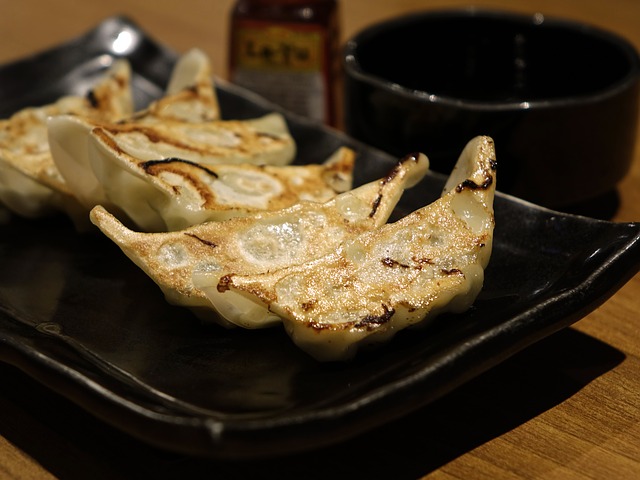
Gyōza may hail from China originally, but it’s a popular dish amongst the Japanese, too. And as big fans of food from that there Nippon, we have a big thing for these tasty little dumplings.
Gyōza
Although hailing from China (where they’re called jiaozi), the Japanese have added a distinctive spin to them – a hint of garlic. That’s the main difference between the nations take on it – but chopsticks are always there.
Technically, gyōza is a type of dumpling. But it’s so light it’s more of an indulgent treat (as it’s fried) that won’t hit your waistline like drinking four litres of Coca-Cola a day will.
Although looking rather nifty once cooked, they’re easy to make. It’s a mish-mash of vegetable fillings wrapped in thin dough. It’s sealed up and fried, boiled, or steamed.
You’ll usually come across gyōza in pan-fried form. It’s served with a black vinegar and sesame seed oil dip.
And, cripes, that’s making us hungry right now thinking about it.
History of Gyōza
It’s believed the Eastern Han dynasty created the dish circa AD 25-220. It’s specifically attributed to Zhang Zhongjing, who was a physician and writer.
But then that’s a folk story against several others. What’s clear is the fried dumpling concept is now incredibly old. This recipe has past through the ages – make no mistake.
It’s thought the Chinese name came from the horn look the dumplings have. “Jiao” means “horn”, you see.
In the Ming dynasty, some chefs thought the dumplings were like pieces of silver. As a result, it became a tradition for some of them to sporadically hide a coin within a jiaozi.
A lucky diner would then either happen upon it in delight, or choke to death in horror.
Either way, you’re not getting away with that now. It’s what you’d class as a serious breach of health and safety protocol, alongside other food preparation standards. Bloody PC, loony lefties ruin everything, don’t they?
Make Your Own
If you want to get deep down and funky, then why not have a go at making some? It’s easy enough, check out the above video.
Have we tried it? No. But then we’re stuck with an electric hob, which is about as effective for cooking as using a pavement on an unusually hot day.
You can also get readymade ones, like we did from the excellent Itsu brand (it also does some exceptional seaweed snacks – oh yes).
Either way, whether you want Itsu to do it for you, or you’re off to a restaurant, or you’re cooking away at home, take your pick.
It’s difficult to go wrong with gyōza. They’re light, tasty, and adaptable for all – whether you’re vegan, a meat-eating bastard, or vegetarian.

And more : right way up, they smile at you.
LikeLiked by 1 person
They be grinning! Does anyone remember smiling?!
LikeLiked by 1 person
It’s my default expression. Or maybe that’s a grin.
LikeLiked by 1 person
I have a grimace. That occasionally lifts into a, sort of, “Yep.” It’s the English way.
LikeLiked by 1 person
They look very yummy…I think I’ll pass on making them myself. They are smiling, so innocent.
LikeLike